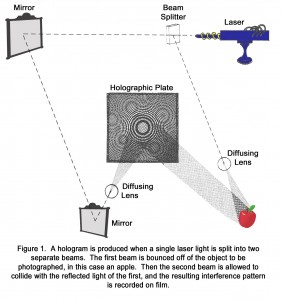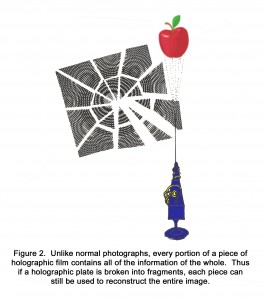Hologram Theory in Acupuncture and Chinese Medicine
Hologram theory is a fundamental principle existing in the universe. This theory can be applied to various practices, especially acupuncture and traditional Chinese medicine. The theories of acupuncture and traditional Chinese medicine include the observation and comprehension of the principles governing the human body and human life. The human body and human life are parts of the universe. The microsytem of the human body reflects the macrosystem of the cosmos (a holographic example). Human life follows the basic principles of the universe. Therefore, hologram theories can be applied everywhere in our study about the human body and life. Understanding and applying these holographic theories helps us comprehend the theories in acupuncture and traditional Chinese medicine. It is also helpful in diagnosing and treating various health conditions.
To understand the hologram theory as it applies to life and the universe, we can examine holographic photography. In holographic photography, any one portion of a hologram contains enough data to reproduce the entire hologram. A hologram is defined as being a three-dimensional image formed by the interference of light beams from a laser or other light source. In holographic photography, when a holographic plate is held up to regular light, it shows only a pattern of splatter marks. The hologram is only seen when the plate is viewed with a special projection device, which provides the appropriate light source. However, should the holographic plate be broken, any one fragment of the plate will show the entire image when viewed in the projection device.
Holograms do not just exist in holographic photography. Like previously mentioned, the universe itself is a giant hologram and every little piece of it contains the whole image. Thus, everything exists as part of a continuum. As David Bohm, a quantum physicist, explains, things can be part of an undivided whole, but all possess unique qualities. Whirlpools or eddies in a river, for example, have their own qualities. For example, whirlpools or eddies in a river have their own qualities such as size, rate, and direction of motion, but it is not possible to distinguish where the whirlpool ends and the river begins. Everything exists in dynamic interconnectedness with everything else.
ECIWO Biology also reflects the hologram theory. ECIWO is an acronym for the Embryo Contains Information of the Whole Organism, which refers to the capacity of embryonic cells to develop into whole organisms. Embryonic cells have the capacity to develop into whole organisms because they contain all the information required by the organism to mature. Embryonic cells have the ability to differentiate into any type of cell. Therefore, a single fragment of the whole organism (the embryonic cell) contains the information (image) of the whole organism (the hologram). For example, a skin cell and a muscle cell both originated from identical embryonic cells. In order to become a skin cell or muscle cell, certain information contained in the embryonic cell was accessed so that the cell could develop and specialize to become that skin cell or muscle cell.

Another example of holograms seen in nature can be taken from the observation of plants. The shape of the leaves or fruit of a plant often reflect their distribution on the plant. For example, Chinese peaches have a large belly and a tiny mouth, reflecting their location in the lower-middle part of the peach tree. Pears and figs have large heads and a small bellies, reflecting their distribution in the upper part of the tree. Apples are round indicating that they are distributed in the middle of the tree. Besides observing plants, other organisms may also be observed to examine how holographic tendencies are displayed. For example, the shape of a chicken egg reflects the shape of the bird that is to hatch from that egg. Eggs that are narrower tend to hatch into roosters, while eggs that are rounder tend to hatch into hens, which are rounder than roosters.
Another example consisting of birds is the correlation between their bills and feet/legs. Most birds with webbed feet have flat bills, while most birds with sharp beaks have sharp talons. Birds that have long or short beaks often have long or short legs, respectively. In humans, such correlations can be seen between different body parts. For example, the tongue is a reflection of the heart, and moves like the heart pulses. The ears are a reflection of the kidneys, and can be located at different heights of the head just like the kidneys can be located at different heights in the body. Furthermore, in humans and animals, the number of fingers or talons often corresponds with the number of the major parts of the body. Humans and primates have five fingers on each hand, reflecting the two arms, two legs, and one torso/head. All of these correlations reflect that, although these structures are specialized, they are interconnected and contain the same information of the whole. This can be seen perhaps more clearly when a new plant is grown from a cutting of another plant. The cutting contained the information of the whole.

The examples are endless because they are reflections of the basic principles of the universe. These basic principles of the universe – that everything is connected and a part of an undivided whole – are necessary to recognize when addressing problems. We cannot fragment the world and ignore the effects on the whole. Nor can we hope to fix problems if we only address these fragmented parts and not the whole. For example, resources cannot be extracted from the earth without affecting the environment and affecting the biosphere. Crime, poverty, and other societal problems cannot be addressed unless they are addressed as a whole, recognizing the root causes and interconnectedness of these problems. Likewise, in promoting health and addressing disease, the body must not be viewed in fragments, but treated holistically, recognizing how every part of the body is interconnected. By applying this principle of interconnectedness – which applies to everything in the universe – to ourselves and our health we can achieve optimal health and wellness.
The hologram theory in traditional Chinese medicine is applied by viewing the extremities of the body as individual microsystems. Some examples of microsystems that are used are the hands, feet, ears, arms, and legs. These microsystems can be seen as holograms of the human body containing all of its structures, such as the head, stomach, legs, arms, etc. The areas of the microsystem that correspond to each structure reflect the functions of said structure. For example, the area in a microsystem that corresponds to the lungs reflects our breathing and other respiratory functions. Because the body’s systems are naturally interconnected, we can treat an issue anywhere in the body by stimulating the corresponding points of the microsystem. Acupuncture, acupressure, and reflexology are based on this principle. When a specific structure in the body is ill or not functioning properly, its corresponding point in the microsystem will be tender and sore. The location of this point is enough information for the practitioner to identify the origin of the illness, the specific structure that is being affected. Stimulating these points with acupuncture, acupressure, or reflexology signals the body to release antibodies, hormones, and proteins to promote healing.

Auricular acupuncture is the practice of diagnosis and treatment of various ailments through examination and stimulation of the ear’s auricular points. The auricle, or outside of the ear, represents a microsystem of the body in the shape of an inverted fetus. Chinese acupuncture points along the ear are in a similar position to the corresponding anatomical areas of the fetus. The head acupuncture points are located on the ear lobe. The major organs of the fetus are located in the center, or concha of the ear, and the lower limbs of the fetus are positioned at the top of the ear. Ailments can be diagnosed by examination of points along the auricle that correspond to various organs in the body. These ailments can then be treated by stimulating the corresponding points.
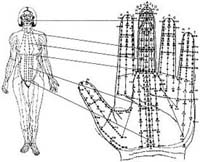

Hands, in addition to the ears, reflect the condition of bodily organs and allow the functions of those organs to be enhanced by stimulation of the corresponding points on this external part of the body. Along the metacarpal bone on the side of the hand (see image above left) there are acupuncture points that correspond with the entire body. A tender or sore sensation when any of these points are applied with pressure indicates a health issue at that site in the body. Additionally, within hand reflexology, each finger corresponds to part of the body, with symmetry between the fingers and the upper limbs, lower limbs and torso (see image above right). The twelve major acupuncture meridians of the body are also reflected on the hands (see image below).
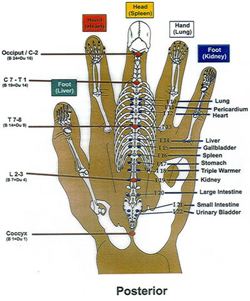
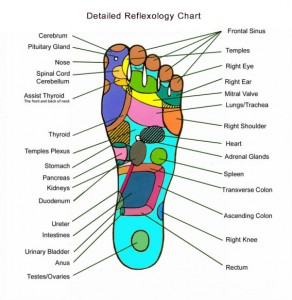
Another microsystem used in reflexology, acupressure, and acupuncture is the foot. Foot reflexology charts show the areas on the foot where the organs of the entire body are reflected. In reflexology and acupressure, patients are treated with massage to the appropriate points on the foot. The foot is not a preferred microsystem for use in acupuncture because the soles of the feet are more sensitive to acupuncture needles than points on the ears, hands, or other areas of the body.
 The face also has acupuncture and acupressure points corresponding to all parts of the body, with symmetry between the microsystem and the body. For example, the two ears correspond with the two kidneys, the two nostrils of the nose correspond with the two lungs (right and left) and the two eyes correspond with the two lobes of the liver (right and left). Facial acupuncture also enhances skin’s quality, texture and appearance due to increased blood circulation and oxygenation of the skin; promotes immune and endocrine systems, thereby optimizing hormone levels; and reduces stress, which promotes synthesis of neuropeptides and endorphins. Furthermore, like the ear, the nose has another web of points relating to body parts such as the head, torso, legs and feet.
The face also has acupuncture and acupressure points corresponding to all parts of the body, with symmetry between the microsystem and the body. For example, the two ears correspond with the two kidneys, the two nostrils of the nose correspond with the two lungs (right and left) and the two eyes correspond with the two lobes of the liver (right and left). Facial acupuncture also enhances skin’s quality, texture and appearance due to increased blood circulation and oxygenation of the skin; promotes immune and endocrine systems, thereby optimizing hormone levels; and reduces stress, which promotes synthesis of neuropeptides and endorphins. Furthermore, like the ear, the nose has another web of points relating to body parts such as the head, torso, legs and feet.
Nature provides redundancy in such magnificent designs as the human body. Our lives began in the womb as a single cell; therefore, there is a part of us in the whole and the whole of us in the part at the same time, as is true of everything in the universe. In acupuncture, this redundancy supports the resiliency of the meridian systems of acupuncture, and demonstrates that there are several pathways from which to access the body’s qi meridians. Acupuncture microsystems offer a unique approach to diagnosing and addressing specific health conditions as well as overall energetic imbalances. The key to effectiveness of this technique is the understanding of the interconnectedness of all things in the universe.
At Acupuncture Boston – HolliBalance Well-being Center, we utilize the theories of hologram extensively in both diagnoses and treatments. Please refer to auricular diagnosis and frozen shoulder treatment.
